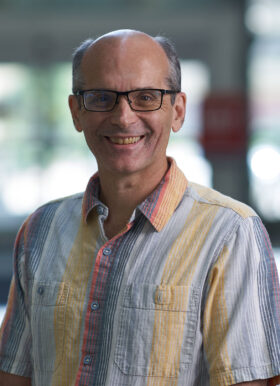
Timothy Holy, PhD
Alan A. & Edith L. Wolff Professor of Neuroscience, Vice Chair of Research
- Phone: 314-362-0086
- Email: holy@nospam.wustl.edu
Research
The Holy laboratory focusses on two major areas of research: (1) studying the neural mechanisms of olfactory coding and the behaviors it triggers, and (2) developing new techniques for imaging neuronal activity and cell type identification.
Olfaction is distinguished among sensory systems by being shallow but broad. It is shallow because there are relatively few stages of “preprocessing” needed before interacting with brain areas involved in innate and learned behaviors; it is broad due to the diversity of inputs stemming from the hundreds or thousands of olfactory receptor genes that detect odors. Historically, this diversity posed a challenge to sensory physiologists. The Holy lab pioneered the use of light sheet microscopy for calcium imaging, and were the first to image from tens of thousands of neurons simultaneously and now routinely record exhaustively from the entire sensory input repertoire. In more recent work, the lab has coupled high-throughput imaging technologies with optical tagging and gene sequencing to develop a new technique, PhOTseq, for identifying gene expression from functionally-defined cell types. These new tools allow us the lab to exploit the diversity of inputs in olfaction as an advantage: natural sensory cues provide us with a “ligogenetic toolkit” permitting exquisite control over activation of a large number of distinct pathways.
Scientifically, some of our major discoveries include the identification of mouse pheromones and some of the natural behaviors they trigger, elucidation of mechanisms of sensory integration in the accessory olfactory bulb, discovery of mechanisms for individuality and plasticity in early sensory perception, and a deeper understanding of the relationship between sequence and function in olfactory receptors. Dr. Holy is also among the world’s foremost creators of Julia, a programming language designed for both ease-of-use and high performance whose adoption is growing exponentially. Ongoing work includes many of these areas as well as new initiatives in technology development, olfactory navigation, learning and memory, computation, and machine learning.
Selected publications
- Kuwabara M, Kang N, Holy TE, Padoa-Schioppa C. Neural mechanisms of economic choices in mice. eLife. 2020; 9:e49669.
- Liang X, Ho MCW, Zhang Y, Li Y, Wu MN, Holy TE, Taghert PH. Morning and evening Circadian pacemakers independently drive premotor centers via a specific dopamine relay. Neuron. 2019; 102:843-857.e4
- Yamada T, Yang Y, Valnegri P, Juric I, Abnousi A, Markwalter KH, Guthrie AN, Godec A, Oldenborg A, Hu M, Holy TE, Bonni A. Publisher-correction: Sensory experience remodels genome architecture in neral circuit to drive motor learning. Nature. 2019; 570(7760):E33. doi: 10.1038/s41586-019-1268-2.
- Greer CJ, Holy TE. Fast objective coupled planar illumination microscopy. Nature Communications. 2019; 10:4483.
- Meeks JP, Arnson HA, Holy TE. Representation and transformation of chemosensory information in the mouse accessory olfactory system. Nature Neuroscience. 2010; 13:723-730.
- Turaga D, Holy TE. Image-based calibration of a deformable mirror in wide-field microscopy. Applied Optics. 2010; 49:2030-2040.
- Nodari F, Hsu F-F, Fu X, Holekamp TF, Kao L-F, Turk J, Holy TE. Sulfated steroids as natural ligands of mouse pheromone-sensing neurons. J Neuroscience. 2008; 28:6407-6418.
- Holekamp TF, Turaga D, Holy TE. Fast three-dimensional fluorescence imaging of activity in neural populations by objective-coupled planar illumination microscopy. Neuron. 2008; 57:661-672.
See a complete list of Dr. Holy’s publications on PubMed.
Education
1991 BA, Mathematics and Physics (summa cum laude), Rice University
1992 MA, Physics, Princeton University
1997 PhD, Physics, Princeton University, Thesis advisor: Stanislas Leibler
Selected honors
2005, 2008, 2014 Distinguished Teaching Service Award
2007 McKnight Technological Innovation in Neuroscience Award
2009 St. Louis Academy of Sciences Innovation Award
2009 NIH Director’s Pioneer Award
2009 Society for Neuroscience Research Award for Innovation in Neuroscience (RAIN)